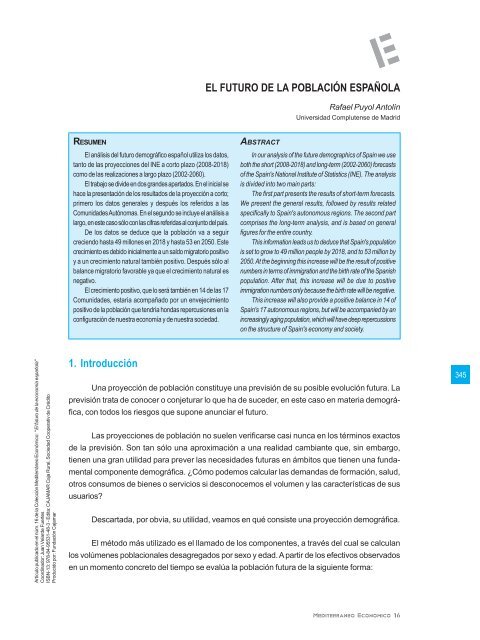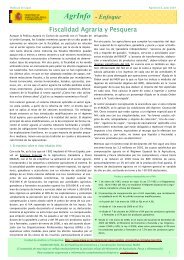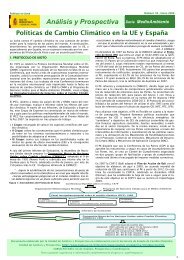El futuro de la economÃa española - Coag
El futuro de la economÃa española - Coag
El futuro de la economÃa española - Coag
You also want an ePaper? Increase the reach of your titles
YUMPU automatically turns print PDFs into web optimized ePapers that Google loves.
EL FUTURO DE LA POBLACIÓN ESPAÑOLARafael Puyol AntolínUniversidad Complutense <strong>de</strong> MadridRESUMEN<strong>El</strong> análisis <strong>de</strong>l <strong>futuro</strong> <strong>de</strong>mográfico español utiliza los datos,tanto <strong>de</strong> <strong>la</strong>s proyecciones <strong>de</strong>l INE a corto p<strong>la</strong>zo (2008-2018)como <strong>de</strong> <strong>la</strong>s realizaciones a <strong>la</strong>rgo p<strong>la</strong>zo (2002-2060).<strong>El</strong> trabajo se divi<strong>de</strong> en dos gran<strong>de</strong>s apartados. En el inicial sehace <strong>la</strong> presentación <strong>de</strong> los resultados <strong>de</strong> <strong>la</strong> proyección a corto;primero los datos generales y <strong>de</strong>spués los referidos a <strong>la</strong>sComunida<strong>de</strong>s Autónomas. En el segundo se incluye el análisis a<strong>la</strong>rgo, en este caso sólo con <strong>la</strong>s cifras referidas al conjunto <strong>de</strong>l país.De los datos se <strong>de</strong>duce que <strong>la</strong> pob<strong>la</strong>ción va a seguircreciendo hasta 49 millones en 2018 y hasta 53 en 2050. Estecrecimiento es <strong>de</strong>bido inicialmente a un saldo migratorio positivoy a un crecimiento natural también positivo. Después sólo alba<strong>la</strong>nce migratorio favorable ya que el crecimiento natural esnegativo.<strong>El</strong> crecimiento positivo, que lo será también en 14 <strong>de</strong> <strong>la</strong>s 17Comunida<strong>de</strong>s, estaría acompañado por un envejecimientopositivo <strong>de</strong> <strong>la</strong> pob<strong>la</strong>ción que tendría hondas repercusiones en <strong>la</strong>configuración <strong>de</strong> nuestra economía y <strong>de</strong> nuestra sociedad.ABSTRACTIn our analysis of the future <strong>de</strong>mographics of Spain we useboth the short (2008-2018) and long-term (2002-2060) forecastsof the Spain's National Institute of Statistics (INE). The analysisis divi<strong>de</strong>d into two main parts:The first part presents the results of short-term forecasts.We present the general results, followed by results re<strong>la</strong>tedspecifically to Spain's autonomous regions. The second partcomprises the long-term analysis, and is based on generalfigures for the entire country.This information leads us to <strong>de</strong>duce that Spain's popu<strong>la</strong>tionis set to grow to 49 million people by 2018, and to 53 million by2050. At the beginning this increase will be the result of positivenumbers in terms of immigration and the birth rate of the Spanishpopu<strong>la</strong>tion. After that, this increase will be due to positiveimmigration numbers only because the birth rate will be negative.This increase will also provi<strong>de</strong> a positive ba<strong>la</strong>nce in 14 ofSpain's 17 autonomous regions, but will be accompanied by anincreasingly aging popu<strong>la</strong>tion, which will have <strong>de</strong>ep repercussionson the structure of Spain's economy and society.Artículo publicado en el núm. 16 <strong>de</strong> <strong>la</strong> Colección Mediterráneo Económico: " <strong>El</strong> <strong>futuro</strong> <strong>de</strong> <strong>la</strong> economía españo<strong>la</strong>"Coordinador: Juan Ve<strong>la</strong>r<strong>de</strong> FuertesISBN-13: 978-84-95531-48-3 - Edita: CAJAMAR Caja Rural, Sociedad Cooperativ <strong>de</strong> CréditoProducido por: Fundación Cajamar1. IntroducciónUna proyección <strong>de</strong> pob<strong>la</strong>ción constituye una previsión <strong>de</strong> su posible evolución futura. Laprevisión trata <strong>de</strong> conocer o conjeturar lo que ha <strong>de</strong> suce<strong>de</strong>r, en este caso en materia <strong>de</strong>mográfica,con todos los riesgos que supone anunciar el <strong>futuro</strong>.Las proyecciones <strong>de</strong> pob<strong>la</strong>ción no suelen verificarse casi nunca en los términos exactos<strong>de</strong> <strong>la</strong> previsión. Son tan sólo una aproximación a una realidad cambiante que, sin embargo,tienen una gran utilidad para prever <strong>la</strong>s necesida<strong>de</strong>s futuras en ámbitos que tienen una fundamentalcomponente <strong>de</strong>mográfica. ¿Cómo po<strong>de</strong>mos calcu<strong>la</strong>r <strong>la</strong>s <strong>de</strong>mandas <strong>de</strong> formación, salud,otros consumos <strong>de</strong> bienes o servicios si <strong>de</strong>sconocemos el volumen y <strong>la</strong>s características <strong>de</strong> sususuarios?Descartada, por obvia, su utilidad, veamos en qué consiste una proyección <strong>de</strong>mográfica.<strong>El</strong> método más utilizado es el l<strong>la</strong>mado <strong>de</strong> los componentes, a través <strong>de</strong>l cual se calcu<strong>la</strong>nlos volúmenes pob<strong>la</strong>cionales <strong>de</strong>sagregados por sexo y edad. A partir <strong>de</strong> los efectivos observadosen un momento concreto <strong>de</strong>l tiempo se evalúa <strong>la</strong> pob<strong>la</strong>ción futura <strong>de</strong> <strong>la</strong> siguiente forma:345
















